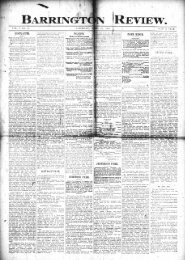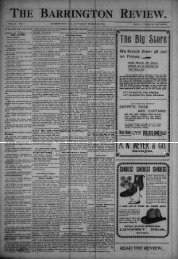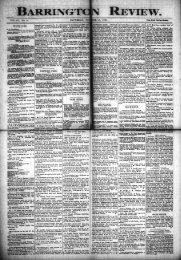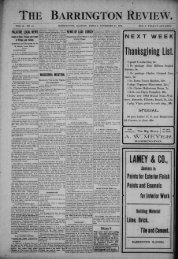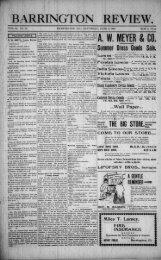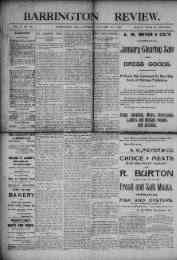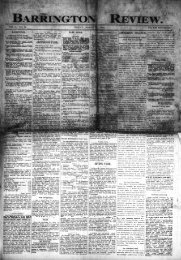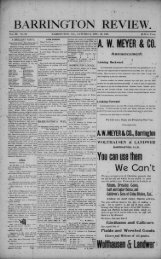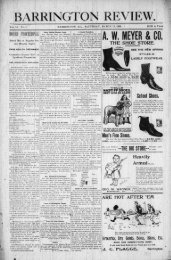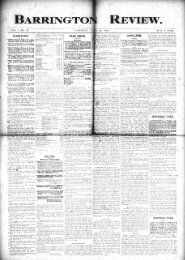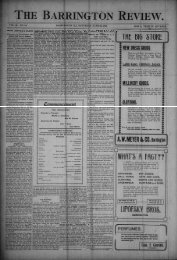m - Barrington Area Library
m - Barrington Area Library
m - Barrington Area Library
You also want an ePaper? Increase the reach of your titles
YUMPU automatically turns print PDFs into web optimized ePapers that Google loves.
FARM MD GARBEN,<br />
«ATTERS OF INTEREST<br />
CULTURISTI<br />
TO AGHI-<br />
lomr Cp-to-D«U Hiato About Cnlti-<br />
vatioa of ti» Soll ond ' Yield»<br />
Thereof—Horticulture, Viticulture and<br />
Floriculture.<br />
MI Analyst* H a Guide.<br />
The Ohio Experiment station receives<br />
many inch requests as the following:<br />
"Will you make a chemical<br />
analysis of my soil to determine whether<br />
I need nitrogen, potash or phosphoric<br />
acid, and, if so, what will he the<br />
charge?"<br />
To this request we make the uniform<br />
answer that such an analysis would<br />
be very expensive/ and when made<br />
would, usually have very little value as<br />
a guide to the use of fertilisers tor the<br />
reason that the chemist has as yet discovered<br />
no reagent which possesses the<br />
same capacity tor extracting plant food<br />
from the soil as that of the living tissues<br />
of the plant To Illustrate: Potash<br />
is a characteristic constituent of<br />
granite rocks, and a soil formed from<br />
such rocks may appear rich in potash<br />
under the chemist's analysis, and yet<br />
If that potash he still In the form of<br />
granite sand It will be yielded up very<br />
slowly to the feeble solvents of the<br />
plant.<br />
Again: In some of the southern<br />
states are immense beds of rocks containing<br />
large percentages of phosphoric<br />
add; but if these rocks are merely<br />
ground and mixed with the soil their<br />
phosphoric acid, which has resisted the<br />
solvent action of soil water for ages,<br />
will continue insoluble, and hence the<br />
necessity for treating these ground<br />
rocks with sulphuric acid, in order to<br />
make their phosphoric acid available.<br />
Still further: When a piece of marshy<br />
land has been drained it is often found<br />
that the crops planted upon it fail to<br />
thrive, although it seems to be very<br />
rich in nitrogen. The remedy here is<br />
to add barnyard manure, something<br />
which savors strongly of carrying coals<br />
to Newcastle: but the explanation is<br />
that the semi-aquatic vegetation which<br />
formerly occupied the land decays so<br />
slowly that cultivatedcrops cannot get<br />
nitrogen rapidly enough for their<br />
needs When the manure Is ^dded,<br />
however. It sets up a fermentation,<br />
which converts the nitrogen bearing<br />
materials Into a more soluble and<br />
hence available form.<br />
For these reasons the only practical<br />
way of learning the needs of a particular<br />
soil Is to make experiments on<br />
that soil, after the general plan of<br />
those described tn the bulletin* of the<br />
Experiment station on the maintenance<br />
of fertility, and thus learn<br />
which combination of fertilising materials<br />
will produce the greatest effect.<br />
—Chas. E. Thome, director Ohio Experiment<br />
Station.<br />
t , - 'K. 1 ' i " • > -. 1<br />
Irrigation la Siberia.<br />
From Farmers' Review: The agricultural<br />
possibilities of Siberia are<br />
vast and but Indifferently understood.<br />
The banishment of Russian political<br />
prisoners to severe and rigorous stations<br />
has created the impression that<br />
all Siberia is frigid and Incapable of<br />
agricultural development. - There are<br />
in the czar's Asiatic dominion millions<br />
of acres of fertile lands splendidly<br />
adapted to the:growth of grains,<br />
and large areas are even now being<br />
farmed. Siberia, "ndwever, is a vast<br />
country and in many sections whfch<br />
have s&own some agricultural develcpmect<br />
the winters are long and cold<br />
while the summers on the [other Jiand<br />
are very warm and dry. Many -of the<br />
small streams which are used for irrigation<br />
dry up during this season,<br />
the ground bakes and agriculture suffers<br />
much. To remedy this evil the<br />
farmers of certain districts construct<br />
cach year storage reservoir*, and in the<br />
summers use the contents, | reservoirs<br />
and all, for the support of their crops.<br />
They* do it in this manner:<br />
During the winter they collect grealt<br />
drifts of snow in the bottoms .of deep,<br />
shaded valleys, rolling it down the<br />
sides in immense snow balls and there<br />
pressing and compacting It jso that it<br />
will be more resistant to thawing. At<br />
the end of the winter they;cover the<br />
enormous piles thus formed with<br />
branches, straw or trash, in order to<br />
protect the snow against the sun's<br />
heat All during the spring this maas<br />
of snow melts a little during the days,<br />
but freezes at night until it becomes<br />
a great solid cake of ice. Then, when<br />
the temperature rises to;summer heat<br />
and the streams begin to dry up from<br />
lack of rain, this snow-Ice commences<br />
to melt away, and by means of a ditch<br />
leading from It, the water which runs<br />
down supplies the river until the recurrence<br />
Of rainfall.—Guy E. Mitchell.<br />
rail Seeding of Alfalfa.<br />
In some sections this summer tame<br />
grass pastures were eaten to the roots<br />
and then the cattle were turned on the<br />
meadows and the*e were grazed as<br />
closely as the pastures. Where this<br />
is the case, it is probable that with usual<br />
conditions during the coming fall<br />
and winter a large part of these pastnvs<br />
and meadows will next spring be<br />
dither dead or so badly killed that they<br />
will have to he plowed up. This means<br />
a severe shortage next year In hay, and<br />
farmers should prepare to meet thiy<br />
shortage now. It ean be met by sow*<br />
lag alfalfa between August IB and<br />
September IS. ^Ifalfa sowed at this<br />
ti&e under favorable conditions will<br />
furnish a good cutting of hay next<br />
May, and with ordinary conditions will<br />
yield three to four cuttings of hay next<br />
'«owner. „ ijpR^<br />
The groundjfer alfalfa should he well<br />
settled before seeding and ohly the surface<br />
made loose. Alfalfa will usually<br />
fa&if seeded la the fall on freshly<br />
plowed ground. Well cultivated corn<br />
fields, with the stalks cut and drawn<br />
off, give ideal conditions. Such fields<br />
should not be plowed but harrowed<br />
only before seeding. Wheat, oats, flax<br />
and'millet stubble ground plowed shallow,<br />
harrowed thoroughly and<br />
to settle before seeding», furnish good<br />
conditions for alfalfa. If such ground<br />
is mellow, plowing may not be necessary,<br />
as the land will only need to be<br />
disced and cross-disced, £ •<br />
The best time to sow Is hi the last<br />
half of August It is safe to sow as<br />
late as September 15 If conditions are<br />
good. . The ground must be well settled,<br />
with a .loose mulch on top and<br />
well saturated With moisture so as to<br />
bring up the seed quickly and force the<br />
fall growth. If either of these conditions<br />
are lac&ing it will not pay to<br />
SOW. f J."<br />
The best way to sow Is with a press<br />
drill, using 20 pounds of seed per acre.<br />
Mix the seed with equal parts, by<br />
measure; of coarse, cornchop or bran.<br />
Drill half the seed one way and crossdrill<br />
the other half. If; necessary to<br />
sow broadcast use 25 to 30 pounds of<br />
seed per acre, cover with a harrow and<br />
roll unless there Is danger from blowing.<br />
It is much better to seed with a<br />
drill. Alfalfa should be sown alone.<br />
The best quality of seed will give the<br />
best stand and the most vigorous<br />
growth and Is always the most profitable<br />
to use, although it costs the most<br />
Alfalfa will grow on any welldrained<br />
soil that will produce com.<br />
It does best on well-drained bottom<br />
land« that do not overflow, but In the<br />
eastern half of Kansas, when properly<br />
handled, Is a profitable crop on upland.<br />
Alfalfa seeded last fall on upland in<br />
Shawnee and Riley counties gave two<br />
good cutting* this .summer before July<br />
5, while tame meadows and prairie<br />
grass on adjoining lands yielded only<br />
half a ton of hay per acre.—H. M. Cottrell,<br />
Agriculturalist Kansas Experiment<br />
Station. -<br />
The Fickle Worm.<br />
In the accompanying illustration is<br />
shown a pickle worm, natural else.<br />
These worms vary much in appearance,<br />
some being of a yellow-ash-white and<br />
very much resembling the inside of<br />
an unripfe melon, while others are<br />
tinged mote or less with green. They<br />
are quite soft and translucent and<br />
there is a transverse row of eight<br />
shiny, slightly elevated spots on each<br />
of the segments.<br />
The worms sppear about the middle<br />
of July and continue their destructive<br />
work tUl the 1st of October. They<br />
attack the little cucumbers Just when<br />
they are of right size for pickles, bore<br />
round holes in them and, feed on thai<br />
tender frtilt They are great feeders,<br />
and as many as three or four will<br />
sometimes be found in a single cucumber.<br />
They develop rapidly and<br />
reach full growth in three to four<br />
weeks. . .1. .<br />
When about to transform, they forsake<br />
the fruit in which they had burrowed,<br />
and drawing together portions<br />
of tome leaf that lies on or near the<br />
ground^ spin a light cocoon of white<br />
silk. In this cocoon, if it is not toe<br />
late in the season, they change to<br />
moths .like the one here shown,^ emerging<br />
in about ten days. The late ones<br />
pass the winters in the cocoon^. The<br />
moth is very strikingly marked! It is<br />
of a yellowish brown color, with an<br />
iris-purple reflection.<br />
Mary Treat, in her book oni "Injurious<br />
Insects," says of it: The pickle<br />
worm it indigenous and has, ^doubtless,<br />
existed in some part or otjier of the<br />
country! from time immemorial: The<br />
French {entomologist, Guenee, gives as<br />
its foodiplant a species of potato, and<br />
it is just possible It may not always<br />
have fed upon the same plants upon<br />
which 14 was first found lip 11x18 country.<br />
The best remedy is hand picking,<br />
feeding the infested fruit to stock.<br />
1 ' ! " i J<br />
B. S. Hoxie of Wisconsin, in a note<br />
to the Farmers' Review,[finds fault<br />
with a recent article on forest preservation.<br />
The sentence that most arouses<br />
his resentment is: "Careful estimates<br />
on the gliowth of the spruce show that<br />
the trees now having a diameter of 18<br />
inches cajnnot be replaced by trees of<br />
the samei size lh less than 160 years."<br />
In commenting on this Mr. Hoxie says:<br />
"While it is true that the spruce, as<br />
well as nearly all the other coniferous<br />
trees, make slow growth during the<br />
first four or five years from seedlings,<br />
they are not slow-growing trees, as<br />
anyone can satisfy himself by counting<br />
the grains or rings in almost any packing<br />
esse of second-growth timber, If<br />
he has not a section of the tree. I<br />
have visited several groves of spruce<br />
and pine—white and Norway—of from<br />
20 to 30 years' planting from the nursery,<br />
and find these trees from 8 to 14<br />
inches In diameter, and from 20 to 40<br />
feet talL I have a cross section of a<br />
spruce that measured IS finches in<br />
diameter one foot from'the ground, and<br />
I count' 24 rings. When cut down the<br />
tree was 11 feet long. This tree grew<br />
on a neighbor's lawn, and I knew the<br />
date of Its transplanting from the<br />
nursery.'* i _<br />
W. J. Stillman, who died recently In<br />
England, was a man of varied talent*—<br />
an artist art critic, author. Journalist<br />
diplomatist and archaeologist He<br />
was an intimate of Rnskln, Mlllals,<br />
Hunt and other members of the pre-«<br />
Raphaelite group.<br />
FOB WOMEN AND HOME<br />
ITEMS <br />
Î WORTHY OF IMITATION.<br />
Tne ostrich is monogamous and uxorious;<br />
a doughty defender of Ids nest<br />
and nestlings. There never yet Was idf<br />
bird, little or big, thai felt seK-eufllc&nb<br />
enough to build [a nest alone.<br />
That form of conceit they leave to the<br />
f^ftherless bipeds of earth. But of all<br />
I lie bird world, not one male In tks<br />
whole lot is as wining as the ostrich<br />
to tuc,k up his tall feathers add go tef<br />
work. Mrs; Ostrich fin not allowed to<br />
«|rt herself too much In the prepara-;<br />
tlOn of the house. He» criticism and<br />
aérice are highly respected, however, ,<br />
so she usually stands near, ready toi'<br />
be of assistance, if needed. An ostrich's<br />
nest Is really a dug-out Just|<br />
the kind of abode suitable for a coun-|<br />
try where wind and sand frequently<br />
g«t mixed up together. The ostrich<br />
digs his home with his strong breastbone,<br />
kicking the sand out behind htmuly<br />
It; takes strength and patience to do|<br />
his work well, for he does not oounts<br />
It finished until he has tiollowed out at<br />
hole about four feet lUt diameter and<br />
oiie foot deep. Sometimes hls strength<br />
fails before the nest is done, and then<br />
Mrs. Ostrich, like a good wife, comes<br />
toi his aid and lepds a helping breastbone,<br />
till he gets his wind again. That<br />
nest ready, Mr. Ostrich conducts his<br />
mate gallantly to her seat of honor<br />
there. Mrs. Ostrich, having a proper |<br />
sense of her obligations to the world s<br />
and the ostriculturist proceeds to lay<br />
in the warm; sandy nest a big white<br />
egg that weighs about three and onehalf<br />
pounds. Every other day she ,<br />
lays one until twelve or fifteen are<br />
side by side in the hole In the ground, t<br />
She and Mr. Ostrich look at them very |<br />
fondly and often, and ail a protection<br />
against the intense heat of the sun<br />
they scatter a little sand ¡over the eggs. |<br />
From this thoughtful act arises that<br />
ancient Superstition that the eggs of<br />
thé ostrich sre hatched by thh sun<br />
without the bird's help. All the time<br />
that Mrs. Ostrich Is performing her '<br />
delicate duty Mr. Ostrich keeps watch«<br />
ful.guard of her. Woe be to the unhappy<br />
creature, be he brute or human, |<br />
who tries to come near.t One blow'of<br />
his foot can dangerously injure; one<br />
cut' of his sharp claw fktally pierces.<br />
Ás defender of his family Mr. Ostrich<br />
is always on duty. He neve? stays<br />
out late at night or even leaves his<br />
spouse to spend a lonely evening while<br />
he swaps stories with the other birds.<br />
As soon as the. full number of eggs<br />
sre" laid he takes his torn sitting on<br />
the nest.—Buffalo Ènqulrer.<br />
THE QUAGGA'S HEELS.<br />
Dwi Effectually la Putting Groat Tlgac<br />
Kajah to Sloap.<br />
An amusing story Is told by Cleveland<br />
Moffet in his paper On "The Wild<br />
Beast Tsmer" In St. Nleholss. j Well,<br />
it Was here that I heard the' story.<br />
Bonávita, It appears, was standing on<br />
the bridge one morning, when there<br />
arose a fearful racket hi the runway,<br />
and looking in he saw the quagga tearing,<br />
along toward him. fre concluded<br />
that some one had unfastened the<br />
door, and was just preparing to check<br />
the animal, when aroutid the curve<br />
came Rajah, the tiger, in full pursuit<br />
Bonavita stepped back, drew his revolver,<br />
and as the tiger rushed past<br />
fire$ a blank cartridge, tjhinking thus<br />
to divert him from the quagga. But<br />
Raj||h paid not me slightest heed, and<br />
In long bounds came out into tne arena<br />
hará after the terrified quagga,«which<br />
was' galloping now with jthe speed .of<br />
despair. A keeper, who i was sweeping,<br />
clambered up the iron sides and<br />
anxiously watched the race from the<br />
top.' Bonavita, powerless to interfere,<br />
watched from tlie bridge.; Of all the<br />
races ever run In a circus, this was<br />
the most remarkable. It. was a race<br />
for life, as the quagga knew and the<br />
tiger intended. Five timies they circled^<br />
the arena, RaJah gaining always,<br />
but never enough for a spring. In<br />
the Sixth turn, 'however, he judged' the<br />
distance right and straightway a<br />
black-and-yellow body Shot through<br />
the'air in true aim at the prey. Whereupon<br />
the quagga did the only thing! a<br />
quagga could do—let out both hind<br />
legs: In one/straight tremendous kick;<br />
and they do say that a quagga can<br />
kick the eyes out' of a fly, At any<br />
rate* In this case a pair off nervous little<br />
heels caught the descending tiger<br />
squarely under the lower jaw, and put<br />
him to sleep like a nice little lullaby.<br />
And that was the end of It The<br />
quagga trotted back to its cage, Bonavita<br />
put up his revolver,; the frightened<br />
'sweeper climbed down from the<br />
bars, and Rajah was hauled back ignomtnlously<br />
to his den.<br />
|f. Getting Caught la 4 LI«.<br />
T 'know ' of no meaner! experience<br />
than to get caught In a lie that there<br />
is no necessity of telling," said a man.<br />
"The other morning a | man with<br />
whom I have only a slight acquaintance<br />
came in and asked me to lend<br />
him £2. There was ino reason why I<br />
should not have refused him outright<br />
but instead I explained that I had<br />
come away from home with only some<br />
small change In my pocket He accepted<br />
the explanation, and we chatted<br />
a while about local politics. It is a<br />
habil of mine, whenever I get into an<br />
argument to polish my eyeglasses. The<br />
best eyeglass polisher in the world is<br />
a banknote. I always keep a banknote<br />
in my waistcoat poeket for this<br />
purpose. I noticed my acquaintance<br />
looking at me peculiarly. And there I<br />
was polishing my eyeglsrtss with a<br />
|2 hlQ. Mo, he didn't ask for tt» hut<br />
he made me fell like thirty cents."—<br />
Philadelphia Times. .r-;<br />
Better twice remembered fhan «Baa<br />
^ -áá . - .t<br />
forgotten.



